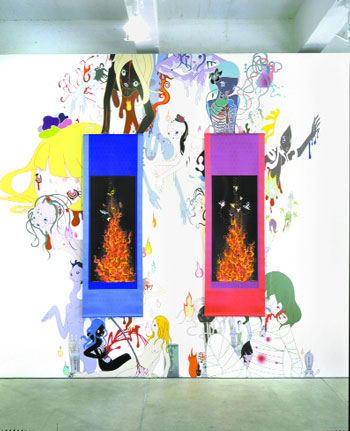Young Japanese women explore a fantastical world of youthful dreams and anxieties
“Tokyo Girls Bravo” is a showcase of the work of ten young Japanese women curated by Takashi Murakami, best known in New York for his piece “Double Helix Reversed” at Rockefeller Center last year and his reworking of the Louis Vuitton logo for bag designs.
In the rest of the world, Murakami has become something of a one-man industry dealing largely in a peculiar but highly exportable Japanese small decorative figures known as “kawaii,” a reference to the childhood-evoking cuteness of the itmes. This show surely has enough cute to go around, ranging from strange stuffed animals, to “me and my friend smiling” or “being chased” types of paintings and drawings.
The women depict their subjects, who are often stand-ins for themselves, in the manner of familiar manga (comic strip) or anime (animation) heroines. Some are pigeon-toed, with big heads and eyes; others are able to fly or transform themselves. These wandering people explore the world around them while commenting on Japanese social issues, but they are plagued with scary and erotic encounters of all sorts.
The inspiration for all this is usually more remote than the Pokeman crew. In fact, the more interesting work in the show contains influences of traditional and even ancient Japanese art. Aya Takano paints in a watercolorish style––reminiscent of Japanese woodblock prints––girls in adventures that force them to contort themselves to survive. One painting, “untitled,” shows girls in yoga-like positions accompanied by symbolic animals on or near them. An installation by Chiho Aoshima combines Yuzen silk scrolls and ink jet printing on the wall behind them. The wall pictures girls cavorting in various states of transformation; damage is combined with Buddhist symbols and signature motifs. The effect is both beautiful and scary. The scrolls are pillars of flame to which moths and fairies have been added.
Mahomi Kunikata, big on ‘Kawaii’, has made some simple paper masks that recall classical Japanese theater, though they are also quite personal. They accompany narrative collage-like drawings, sometimes including elements that are sexual and/or violent. Other work is deliberately childlike and very busy.
These artisits range in age from 20 to 30. The overriding impression with which one comes away from this show is the notion that a young girl’s bedroom is metaphor for the caldron from which all good and evil springs. There is a lot of anxious imagination going on here, but also the sense of play from which good art emerges.




































